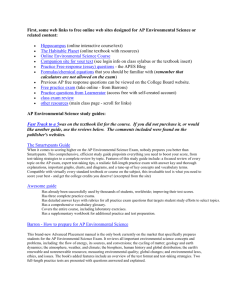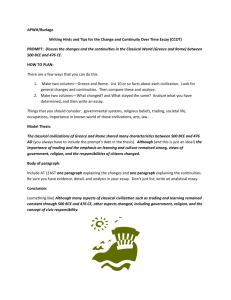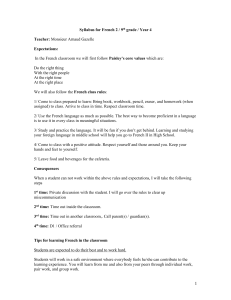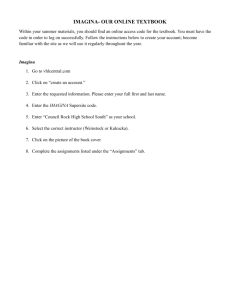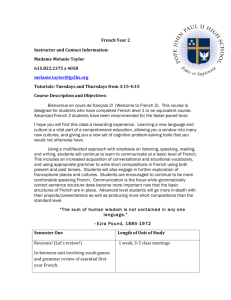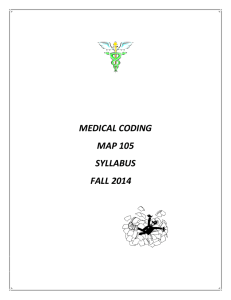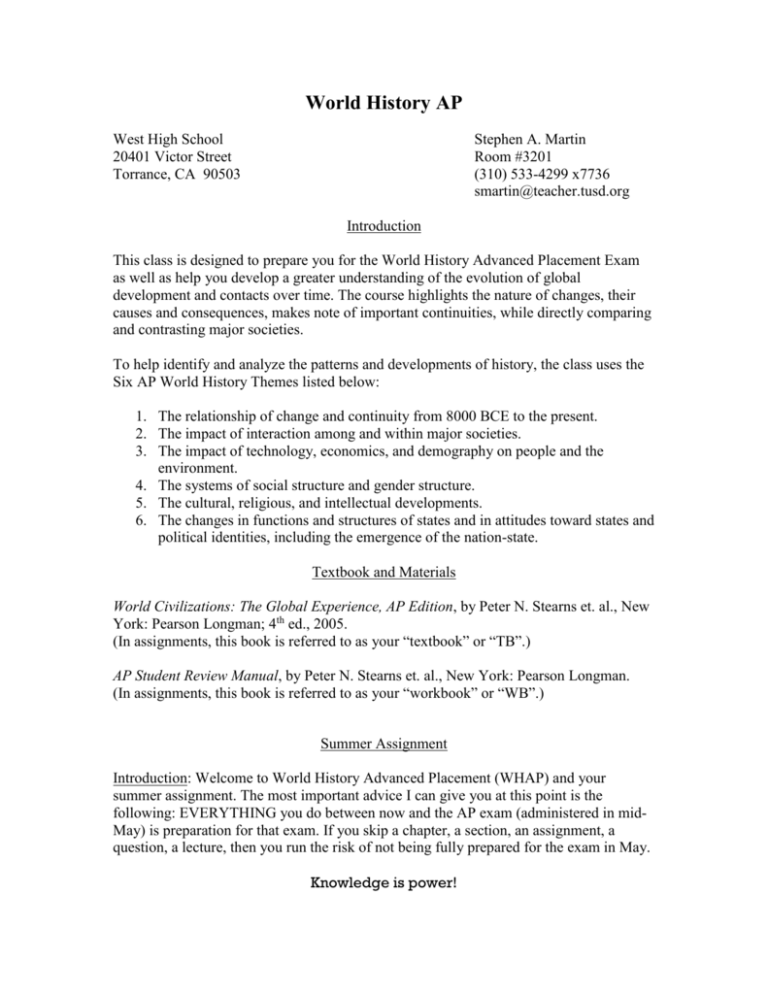
World History AP
West High School
20401 Victor Street
Torrance, CA 90503
Stephen A. Martin
Room #3201
(310) 533-4299 x7736
smartin@teacher.tusd.org
Introduction
This class is designed to prepare you for the World History Advanced Placement Exam
as well as help you develop a greater understanding of the evolution of global
development and contacts over time. The course highlights the nature of changes, their
causes and consequences, makes note of important continuities, while directly comparing
and contrasting major societies.
To help identify and analyze the patterns and developments of history, the class uses the
Six AP World History Themes listed below:
1. The relationship of change and continuity from 8000 BCE to the present.
2. The impact of interaction among and within major societies.
3. The impact of technology, economics, and demography on people and the
environment.
4. The systems of social structure and gender structure.
5. The cultural, religious, and intellectual developments.
6. The changes in functions and structures of states and in attitudes toward states and
political identities, including the emergence of the nation-state.
Textbook and Materials
World Civilizations: The Global Experience, AP Edition, by Peter N. Stearns et. al., New
York: Pearson Longman; 4th ed., 2005.
(In assignments, this book is referred to as your “textbook” or “TB”.)
AP Student Review Manual, by Peter N. Stearns et. al., New York: Pearson Longman.
(In assignments, this book is referred to as your “workbook” or “WB”.)
Summer Assignment
Introduction: Welcome to World History Advanced Placement (WHAP) and your
summer assignment. The most important advice I can give you at this point is the
following: EVERYTHING you do between now and the AP exam (administered in midMay) is preparation for that exam. If you skip a chapter, a section, an assignment, a
question, a lecture, then you run the risk of not being fully prepared for the exam in May.
Knowledge is power!
All of the following assignments (reading and writing) should be completed by Friday,
September 5, 2008. All written assignments should be completed in a notebook that is
used exclusively for this class. There will be times when I ask you to turn in this
notebook so I may comment on your writing. You will also need a separate notebook in
which to take notes. I HIGHLY recommend that you do not use loose-leaf notebook
paper for any of these assignments.
Assignment:
Unit I: Foundations; Rise of Agricultural
Civilizations (8000 BCE – 1000 BCE)
Read the following in the textbook:
Preface: pages xvii – xxiii
Prologue: pages xxix – xxx (See Note 1)
Introduction: pages 2 – 5
Chapter 1: pages 6 – 29
Read the following in the workbook:
pages vi – ix and pages 1 – 7
Do the following from the workbook:
Prologue (Workbook page 8; Textbook
pages xxix – xxx)
Section Review: Questions A, B, C (½
page each)
Multiple Choice: all (See Note 2 below)
Part 1 (WB 9 – 11; TB 2 – 5)
Unit Overview: B, D, E (½ page each)
Multiple Choice: all
Geography: I, II (See Note 3 below)
Chapter 1 (WB 12 – 18; TB 6 – 29)
Chapter Review: B, C, F, J (½ page
each)
Map Exercise: A, B, D
Multiple Choice: all
Essay: Outline B, C, D (See Note 4
below)
Consider the following:
Can you compare/contrast different river civilizations?
Can you compare/contrast the basic criteria for what makes a civilization?
Can you trace how daily life changed and remained the same (continuities) from the
beginning of this time period to the end?
To answer the above, consider the changes and continuities in labor systems, the status of
women, poor people (underclass).
Note 1: In each chapter in the workbook there is a vocabulary section. You need not write
the definition of each word, but it is assumed that you know the definition and can use the
word correctly. Every test you take (multiple choice and essay) assumes that you know
these words.
Note 2: Because nothing is easy, the multiple choice answer keys are at the end of each
unit. But wait, you say, that is easy. Well, it has been discovered that some of the answer
keys are wrong or mixed up. Check your answers with the answer key; when you think
the answer key is wrong, this is a great opportunity to ask a question in class, discuss
your reasoning, and otherwise impress you classmates and teacher with your study skills.
Note 3: Knowing the geography of the world is CRITICAL to doing well on the exam.
To facilitate this knowledge here is what you must do:
On a blank, white, 8 ½ x 11, piece of paper, make a freehand map of the following
sections of the globe. A freehand map means you look a map and draw (NOT TRACE)
what you see. The hard part is keeping the proportions correct. This may take you some
time; do not rush yourself. At the back of the workbook there are several maps that you
may find useful. You can also use your textbook or an atlas. DO NOT draw in modern
borders; you only want landmasses, rivers, and lakes. Draw a freehand map of each
section of the globe listed below in PENCIL: Mesopotamia/Middle East, Eastern
Mediterranean, Indian Ocean (from East Africa to Southeast Asia), The Mediterranean
Region, Saharan and Trans-Saharan Africa, Tropical Africa, Southern Africa, East Asia,
Meso-America, South America, Northern Europe, Western Europe, Southeast Asia.
When you are satisfied with your depiction, ink in the lines in BLACK.
Keep these 13 maps in pristine condition; they are your master maps. Make photocopies
of the maps to do the various geography assignments during the year. You will discover
that while the landmasses and rivers are fairly steadfast, political units come and go. You
will use copies of your master maps to draw in the political boundaries of various
civilizations, empires, and nations as time marches on.
Note 4: The man who is the chief author of your textbook is also a chief writer/designer
of the AP exam. Therefore, what he says in the book often appears on the AP exam.
Furthermore, the essay questions at the end of each chapter are extremely important. You
should not write a full-fledged essay, merely an outline. A sample outline for question A
is what follows; you should do your best to emulate this with your outlines. As the year
progresses, your outlines will become more sophisticated and detailed.
Thesis Statement (T.S.): Because human groups were small and lacked job
specialization, gender differences meant little until more complex societies were formed
during the Agricultural Revolution.
Description of typical Paleolithic society
Hunting and gathering
Little food surplus
Few inter-tribe conflicts
Therefore: women have quasiequal status with men
Agricultural Revolution
Domestication of animals and
grains
Food surplus → job
specialization
Increase in inter-tribe conflict
Therefore: women have domestic
tasks
Specific Example: Sumer
Prior to AR, women gather food
with men
After AR, women hidden in
house, used in marriage to
complete political or financial
alliances; divorce becomes taboo,
marriage comes with a dowry.

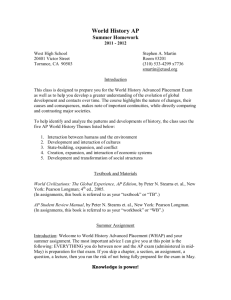
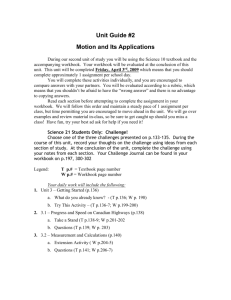

![Submission 68 [doc]](http://s3.studylib.net/store/data/008000926_1-fed8eecce2c352250fd5345b7293db49-300x300.png)
